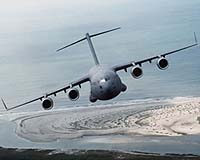| . |  |
. |
Patuxent River MD (SPX) Jan 08, 2010 The Lockheed Martin F-35B Lightning II short takeoff/vertical landing (STOVL) stealth fighter engaged its STOVL propulsion system in flight for the first time today. The successful test is the first in a series of planned STOVL-mode flights that will include short takeoffs, hovers and vertical landings. "The joint F-35 industry and government team has already shown during extended ground tests that the STOVL propulsion system performs well, and thousands of hours of component testing has validated its durability. Now we are seeing early proof that the system operates in flight as our team predicted," said Dan Crowley, Lockheed Martin executive vice president and F-35 program general manager. The aircraft is powered by a single Pratt and Whitney F135 engine driving a Rolls-Royce LiftFan. The system, which includes a Rolls-Royce 3-bearing swivel duct that vectors engine thrust and under-wing roll ducts that provide lateral stability, produces more than 41,000 pounds of vertical thrust. The F135 is the most powerful engine ever flown in a fighter aircraft. F-35 Lead STOVL Pilot Graham Tomlinson of BAE Systems took off at 1:53 p.m. EST, climbed to 5,000 feet and engaged the shaft-driven LiftFan propulsion system at 210 knots (288 mph), then slowed to 180 knots (207 mph) with the system engaged before accelerating to 210 knots and converting back to conventional-flight mode. The STOVL propulsion system was engaged for a total of 14 minutes during the flight. Tomlinson landed at 2:41 p.m. EST. STOVL-mode flights will continue, with the aircraft flying progressively slower, hovering, and ultimately landing vertically. Most STOVL-mode testing will be conducted at NAS Patuxent River. The F-35B will replace U.S. Marine Corps AV-8B STOVL fighters, F/A-18 strike fighters and EA-6B electronic attack aircraft. The United Kingdom's Royal Air Force and Royal Navy, as well as the Italian Air Force and Navy, also will employ the F-35B. With its short takeoff and vertical landing capabilities, the F-35B will enable allied forces to conduct operations from small ships and unprepared fields, enabling expeditionary operations around the globe. The Lockheed Martin F-35 is a 5th generation fighter, uniquely characterized by advanced stealth with supersonic speed and high agility, sensor fusion, network-enabled capabilities and advanced sustainment. The three F-35 variants are derived from a common design, are being developed together and will use the same sustainment infrastructure worldwide, bringing economies of commonality and scale. The United States and eight international partners are planning to buy more than 3,000 F-35 aircraft. Lockheed Martin is developing the F-35 with its principal industrial partners, Northrop Grumman and BAE Systems. Two separate, interchangeable F-35 engines are under development: the Pratt and Whitney F135 and the GE Rolls-Royce Fighter Engine Team F136.
Share This Article With Planet Earth
Related Links Lockheed Martin The latest in Military Technology for the 21st century at SpaceWar.com
 U.A.E. adds 6 C-17s to air force fleet
U.A.E. adds 6 C-17s to air force fleetAbu Dhabi, United Arab Emirates (UPI) Jan 6, 2009 The United Arab Emirates has agreed to buy six C-17 military aircraft from Boeing. The terms of the contract were not disclosed, but with each aircraft estimated at $250 million, analysts suggest the deal could top $1.5 billion. The deal makes the U.A.E. the second nation in the Middle East, after Qatar, to buy the popular airlifter. A joint statement issued by Boeing and ... read more |
|
| The content herein, unless otherwise known to be public domain, are Copyright 1995-2009 - SpaceDaily. AFP and UPI Wire Stories are copyright Agence France-Presse and United Press International. ESA Portal Reports are copyright European Space Agency. All NASA sourced material is public domain. Additional copyrights may apply in whole or part to other bona fide parties. Advertising does not imply endorsement,agreement or approval of any opinions, statements or information provided by SpaceDaily on any Web page published or hosted by SpaceDaily. Privacy Statement |